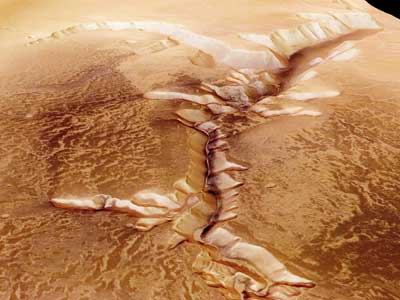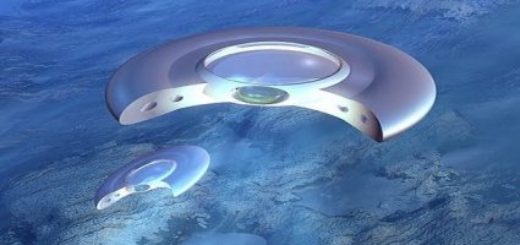Is there really water on Mars?

For many earthlings, 2008 was a year of too much or too little water. While droughts and floods on this planet kept many people occupied, others had their eyes on the weather forecast millions of miles away, as the Phoenix Mars Lander touched down on our sister planet.
In the 1800s, human imaginations ran wild as astronomers glimpsed what they took to be canals on the Martian surface. Scientists pondered the possibility of life on the red planet, while artists and dreamers such as H.G. Wells took the notion even further, imagining a Martian conquest of Earth in his 1898 book “War of the Worlds.” As the decades rolled by, scientific discoveries subdued our expectations, but the questions remained: Has Mars ever supported life, and could it ever support human colonies? Both scenarios depend on liquid water.
In 2005, after 14 successful missions to Mars, these questions were still prevalent when NASA launched the Mars Reconnaissance Orbiter into space. But when scientists compared high-resolution 3-D images of Mars taken by the orbiter to images from 1999, they noticed something unusual. A series of bright, depository streaks had formed in gullies during the intervening years. Since flash floods can carve away soil and leave behind new sediments on Earth, some observers thought they finally had strong evidence that liquid water, and therefore the potential for life, existed on Mars.
Since life as we know it — even the most bizarre varieties — depends on liquid water, scientists assume that it would also be a necessity for extraterrestrial organisms. Mars is replete with water, but most (if not all) of it is in frozen or vapor form. For instance, ice caps the planet’s poles, and patches of ice lie over dunes in craters [source: Fountain].
But until the Mars Reconnaissance Orbiter started circling the planet and the Phoenix Mars Lander landed on it, most people assumed that if Mars once had liquid water, it hadn’t for some time. The planet’s atmosphere and temperature make the idea of liquid water seem impossible. The planet is extremely dry, and its distance from the sun keeps the temperature between 22 and -124 degrees Fahrenheit (-5.5 and -86.7 degrees Celsius).
However, liquid water on Mars wouldn’t necessarily be the same as liquid water on Earth. If the water were highly acidic, for example, it would have a lower freezing point and could maintain its liquid state in the chilly climate [source: Lovett].
But where would liquid Martian water come from? What else could have caused the depository streaks? Go to the next page to find out, thirsty reader.
The Mars Reconnaissance Orbiter
The High Resolution Imaging Science Experiment (HiRISE) camera captured images of gully channels on Mars.
The High Resolution Imaging Science Experiment (HiRISE) camera captured images of gully channels on Mars.
NASA/JPL/UNIVERSITY OF ARIZONA
While the sudden appearance of depository streaks thrilled many scientists, others began to question the flash-flood theory. Further analysis of at least one of the gullies suggested that its shape didn’t match the way fast-moving water flows. The deposits’ fingerlike shape suggested something granular and dry, like fine-grained sand, rushed through the valley [source: Lovett].
However, the shape of the gullies doesn’t completely discount the possibility that there was liquid water involved. Even if the gullies were carved by sand, wet conditions could have initiated the landslide or a small amount of water could have mixed with dirt and sand to form slurry [source: Lovett].
The images that first got scientists speculating came from the High Resolution Imaging Science Experiment (HiRISE), a camera that can capture minute landscape details and geologic structures. It’s one of six instruments that make up the Mars Reconnaissance Orbiter, which was launched with the mission to hunt for evidence of water. Scientists hope the mission will also clarify the climate and geology of the planet, but the orbiter’s scientific payload focuses squarely on H20.
By now, you’ve probably gathered that the orbiter isn’t looking for some stray puddles or some body of water that scientists missed on previous surveys of the planet. Instead, the orbiter’s cameras and spectrometers are searching for mineral deposits left by water. A sounder uses radar to find underground liquid reserves. Other cameras monitor clouds and dust storms. All the information from the Mars Reconnaissance Orbiter is relayed back to Earth through X-band and Ka-band radio waves that are picked up by the Deep Space Network antenna in Canberra, Australia.
In the past, orbiting spacecraft have observed two groups of hydrated minerals on Mars: phyllosilicates, which formed 3.5 billion years ago when Martian water encountered rock, and hydrated sulfates, which formed 3 billion years ago due to evaporation. In 2008, however, the Mars Reconnaissance Orbiter discovered new hydrated minerals on the red planet in the form of hydrated silica, also known as opal. These newly discovered minerals formed when water was exposed to areas affected by meteorites or volcanic activity. These findings have shaved a billion years off previous estimates, indicating that Mars may have had liquid water as recently as 2 billion years ago.
The orbiter also returned evidence of clay mineral deposits that only could have formed due to rock-fracture plumbing and water altering the landscape in early Martian history. Scientists think that flowing Martian groundwater formed these crevices in the planet’s distant past.
The Mars Reconnaissance Orbiter wasn’t the only spy on the red planet over the last year. While the orbiter examined Mars from space, the Phoenix Mars Lander entered the planet’s atmosphere to scope out conditions on the ground.



 Creators of mankind
Creators of mankind Description of “Tall white aliens”
Description of “Tall white aliens” Where they came from?
Where they came from? About hostile civilizations
About hostile civilizations The war for the Earth
The war for the Earth “Tall white aliens” about eternal life
“Tall white aliens” about eternal life Video: “Nordic aliens”
Video: “Nordic aliens” Aliens
Aliens Alien encounters
Alien encounters The aliens base
The aliens base UFO
UFO Technology UFO
Technology UFO Underground civilization
Underground civilization Ancient alien artifacts
Ancient alien artifacts Military and UFO
Military and UFO Mysteries and hypotheses
Mysteries and hypotheses Scientific facts
Scientific facts


















